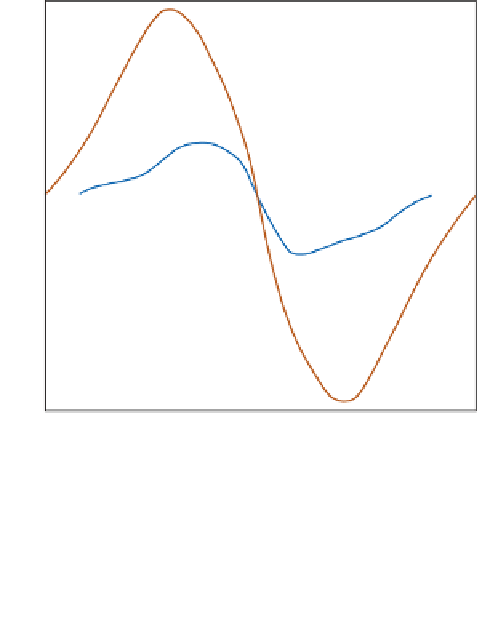Geoscience Reference
In-Depth Information
mainly in the lowest 2 km or 3 km of the atmosphere. It
is closely related to the surface wind network. The sensible
heat transfer (that is, of warm air masses) occurs both close
to the ground surface and also at high altitudes (around
10 km). Both flows, however, are balanced by counter-
flows of cooler air from higher latitudes.
Thus the three main processes of energy transfer at a
global scale are:
5
4
3
2
1
0
1
1
The horizontal transfer of sensible heat by warm air
masses.
2
2
The transfer of latent heat in the form of atmospheric
moisture.
3
3
The horizontal convection of sensible heat by ocean
currents.
4
5
Of these three processes, the first and third are most
important, each accounting for about 40 per cent of the
total annual energy flow. However, methods used to
calculate the values are imprecise and there is considerable
spatial variability to complicate matters.
We shall consider the detailed processes involved in
these transfers in
Chapter 3,
and will see there the factors
that lead to the spatial distribution of these transfer
mechanisms, but it is worth noting here that marked
latitudinal variations in the three processes occur. Sensible
heat transfers by the atmosphere, for example, are at a
maximum between 50
6
90°N 80 70 60 50 40 30 20 10 0
10 20 30 40 50 60 70 80 90°S
Latitude
components of the poleward energy transfer in the earth-
atmosphere system.
Source: After Sellers (1965)
about by a variety of processes. Undoubtedly the main
transfers occur in the atmosphere. Winds carry warm air
and water vapour away from the tropics. The warm air
thus transfers heat (thermal energy) to the cooler
latitudes. The water vapour carries energy in the form
of latent heat. When the water vapour condenses, this
energy is released as heat and warms the surrounding
atmosphere. The oceans, too, transfer significant amounts
of energy polewards. Heating of the sea in equatorial
areas creates a temperature gradient between the lower
and higher latitudes. Ocean currents carry the warmer
waters down this gradient by a process of
lateral
convection
, that is, the force created by the difference in
temperature between one part of the ocean and another.
Equally important, surface winds move water polewards
and equatorwards, a reflection of the close interaction
between atmosphere and ocean.
In both air and sea, however, the transfers are not one-
way. If that were the case, we would be faced with a build-
up of air and water in the higher latitudes and a slow
emptying of the tropical areas. Clearly this does not
happen; the warm air and ocean currents that flow towards
the poles are replaced by a counter-flow of cooler air and
water moving equatorwards. In the case of the sea, the flow
tends to occur at depth, for the cool water sinks. In the air,
the pattern is a little more complex. The transfer of latent
heat (that is, energy tied up within water vapour) occurs
and 60
north and south of the
equator, and again at 10
north and south (
Figure
referred to earlier; the higher-level transfers are dominant
in the subtropical zone, while surface transfers are most
active in middle latitudes.
The transfer of latent heat also shows a complex
pattern, related to the distribution of water vapour in the
atmosphere and the dominant, lower-level wind patterns.
Thus its main effects are seen between 20
and 50
north
and south of the equator, where winds blowing outward
from the subtropics carry moist air polewards. Nearer
the equator the pattern is reversed. Winds created by
equatorial low pressures carry this air into the lower
latitudes. As we shall see in
Chapter 6,
this pattern is
closely related to the global wind system. Oceanic transfers
of energy are most important either side of the equator,
reflecting the outward movement of warm water from the
tropical region. As the waters move polewards they lose
heat to the overlying air. As wind patterns move air
eastwards at these higher latitudes, the heat released by the
sea eventually warms the western coasts of the continents
such as North America and Europe. Satellite evidence
would suggest a higher figure of heat transfer by oceans
and 30







































































































